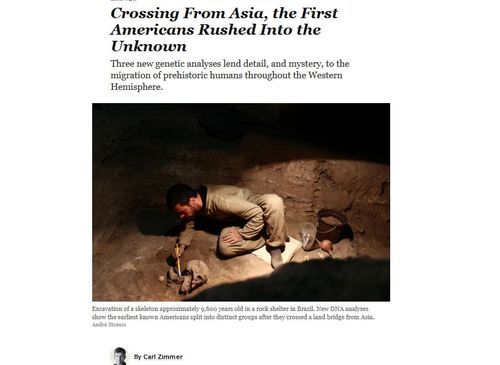
By Steve Sailer
11/09/2018
The high tech graverobbing business has finally started to get its hands on some New World DNA. American Indian tribes have been particularly resistant to letting ancient skeletons found in their region be genome scanned, so most of the ancient DNA work in the past involved Canadian or Latin American skeletons. But now some American Indian tribes are opening up to being sweet-talked into letting DNA scientists like David Reich have a look.
Most of the results in the three new studies are pretty much in line with what physical paleontologists had hypothesized a long time ago: Siberians crossed over the Bering Strait and had a real good time hunting big, dumb beasts all the way down to Tierra del Fuego. Carl Zimmer reports in the NYT:
The genetic data suggest that this group spread swiftly across much of North America and South America about 14,000 years ago. The expansion may have taken only centuries.
“It’s basically an explosion,” Dr. Willerslev said.
The man from Spirit Cave in Nevada belonged to this so-called southern branch of migrants. He also was closely related to a 12,700-year-old boy found on the other side of the Rocky Mountains in Montana, Dr. Willerslev also found.
But the man from Spirit Cave also turned out to have a close genetic link to 10,400-year-old skeletons found in Brazil, on the other side of the Equator.
David Reich of Harvard University and his colleagues found a similar pattern in their own research, published on Thursday in the journal Cell.
They uncovered a link between the ancient Montana boy and another group of ancient South Americans, including a 10,900-year-old skeleton in Chile. Like Dr. Willerslev’s work, the kinship suggests that migrants moved quickly from North America to South America.
“We agree that this must be a rapid radiation,” said Dr. Reich.
But much as the old Big Picture was confirmed, there is also new detail of subsequent migrations and conquests among New Worlders.
Starting about 9,000 years ago, both teams found, additional waves of people moved southward. Dr. Willerslev’s research suggests the new arrivals mixed with older South American populations.
Dr. Reich, on the other hand, sees evidence for two waves of migrants who completely replaced the people who had lived in South America.
Reich, whose father was head of the Holocaust Memorial in D.C., tends to see ancient genocides in his data, events bloodier than other scientists perhaps feel comfortable theorizing.
The new research also revealed instances of remarkable continuity, kinships that spanned thousands of years.
Dr. Willerslev and his colleagues compared the genome of the man from Spirit Cave to those of four sets of remains found nearby in Nevada’s Lovelock Cave, who lived as recently as 600 years ago.
All of these people were closely related, his team found, despite being separated by 10,000 years of history.
A similar bond was found in the Andes. John Lindo of Emory University and his colleagues analyzed DNA from seven people who lived at high elevations between 6,800 and 1,400 years ago.
The researchers estimate that people who lived above 7,500 feet in the mountains were separated from the lowland populations between 9,200 and 8,200 years ago. Today, the mountain people still show a strong genetic link to the ancient remains.
“This is not something that you see in most other regions of the world,” said Dr. Reich.
Perhaps the Altiplano highlanders had evolved some adaptations to thin atmospheres, making them harder to dislodge by lowland newcomers.
In 2015, Dr. Reich and his colleagues found that some living people in the Amazon carry some DNA that’s most similar to that of people who live today in Australia and New Guinea.
This was a very weird discovery — that about 2% of the ancestry of a few Amazonian tribes appeared more closely related to Andaman Islanders in the Indian Ocean than to anybody else closer.
The researchers speculated that their ancestry included an unknown group, which the scientists called Population Y, who separately made their way into the Americas.
This got some attention for awhile, but nobody made much progress on the question of how could anybody get from the Indian Ocean to Brazil.
In their new study, Dr. Reich and his colleagues found no trace of Population Y — but Dr. Willerslev’s team succeeded in identifying their DNA in some of the 10,400-year-old skeletons in Brazil.
So, a little bit more evidence that this is for real.
This is a content archive of VDARE.com, which Letitia James forced off of the Internet using lawfare.